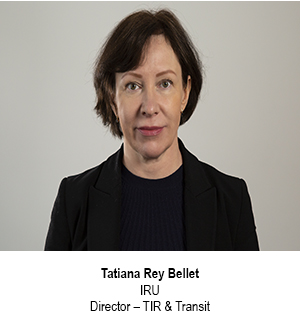Newsletter - Volume I
News |
|
The first electronic TIR (eTIR) transport in line with the Customs Convention on the International Transport of Goods under Cover of TIR Carnets (TIR Convention) has taken place between Uzbekistan and Azerbaijan. Four packages of dried and fresh fruits were transported first by truck and then by plane from the airport of Tashkent to the airport of Baku, following the eTIR procedure and thus paving the way for a new, digital era of the TIR system. This development crowns long-lasting efforts by UNECE’s TIR Secretariat to modernize international transport and transit in cooperation with the contracting parties to the TIR Convention and the private sector. The TIR Convention provides for an internationally recognized procedure to facilitate the cross-border transportation of goods in transit through the use of a standard, internationally recognized customs document – the TIR Carnet. However, with advances in technology, the use of the paper TIR Carnet has become increasingly archaic, especially when it comes to linking it to the electronic procedures applied by national customs administrations. The implementation of eTIR was made possible after the adoption of Annex 11 to the TIR Convention, which came into force in May 2021. Annex 11 regulates the eTIR procedure, including hosting and administration of the eTIR international system, authentication of the holders, as well as the composition, functions, and rules of procedure of the eTIR Technical Implementation Body. During 2022, the TIR Secretariat finalized the development of eTIR international system and started its interconnection with the national customs systems. So far, Azerbaijan, Georgia, Uzbekistan and the International Road Transport Union (IRU) have finalized the interconnection to the eTIR international system in accordance with Annex 11 and passed the mandatory conformance tests. Tunisia and Pakistan have also finalized the interconnection, but still need to pass the conformance tests. Another country that is planning to finalize the interconnection to eTIR in the near future is Türkiye. In 2023, the TIR secretariat plans to expand the interconnection of national customs systems with the eTIR international system to as many of 77 contracting parties as possible, especially along the corridors connecting Central Asian and Middle Eastern countries. That will make eTIR the main way of undertaking transportation under TIR carnets in the near future and will significantly increase security and safety of the TIR system. It will also reduce administrative costs and the time to handle TIR carnets. The expansion of eTIR will increase the overall competitiveness of the TIR system for intermodal transport. Finally, the provision of advance cargo information and the exchange of information in real time will speed up the TIR procedure. Learn how the eTIR system functions: eTIR Home | etir Watch our video: eTIR turn borders into bridges - YouTube More about TIR Convention: Introduction | UNECE |
Testimonials |
|
The first eTIR transport is a small step towards a bigger future of a TIR system that is simpler, safer, more transparent and accessible. 1 - What could be the possible advantages from the implementation of eTIR? By the end of 2022, the Republic of Uzbekistan is the second country in the world which uses TIR Carnets. Every year, uzbek carriers use around 100,000 TIR Carnets. This widespread use of the TIR system is due to the geographical location of the country, namely, as a "double-locked" country (there are only two such countries in the world, the other being "Liechtenstein"), which needs to cross at least two countries to reach the sea, therefore land transport is the main mode of transport there. The TIR system reduces costs for carriers in transit countries through the use of an international guarantee, reduces the bureaucratic burden through the use of a common TIR Carnet format and a mutual recognition mechanism for customs controls, thereby maintaining competitiveness. With a number of listed advantages, the TIR system was limited to paper, making it vulnerable to the age of global digitalisation. However, switching to eTIR removes all limitations and has a host of benefits, for public authorities and the private sector, such as:
The Republic of Uzbekistan expects all these benefits from the implementation of eTIR and hopes that the digitalisation will have a positive impact on many areas of transport. 2 - What do you think should be the next steps in order to take fully advantage of the new TIR electronic system? As of today, the Republic of Uzbekistan has fully completed the connection of the national customs information system to the eTIR international system. However, according to Annex 11 of the TIR Convention, the eTIR can not be used for transports taking place partly within the territory of a country which is not bound by Annex 11 of the TIR Convention. Accordingly, it is considered appropriate that the next steps will focus on expanding the use of eTIR on a geographical scale, as well as improving its mechanisms and mutual assistance of countries in joining national customs systems to the eTIR international system. 3 - Transport and border crossing facilitation: What are the challenges that your region faces? Please suggest possible actions. In recent years, the countries of the Central Asian region have been cooperating closely on facilitating border crossing and to improve transport connections. At the same time, digital solutions are being developed and improved in the field of border crossing points, inter-governmental and inter-agency information exchange is being set up. However, due to the increase in foreign trade turnover and the development of the transport industry, carriers at the region's border crossing points are facing many problems:
The only right solution, in our view, is to follow international best practices, namely in line with the World Trade Organisation's Trade Facilitation Agreements and the Revised Kyoto Convention. Such practices include simplification and digitalisation of declaration and clearance procedures, use of the Single Window principle, freedom of transit, etc. It should be noted that the eTIR procedure is also one of the effective tools to speed up and simplify trade. |

1 - What could be the possible advantages for your country from the implementation of eTIR? Our country is located on the East-West transit route (China, Central Asia, Europe) and the North-South transit route (Russia-Iran-India), and the TRACECA corridor so eTIR system would help us increase the attractiveness of the territory for international transportation, implementation of fully digitalized transit operations, acceleration of border crossing procedures in international transportation, optimization of procedures related to transit operations at BCP. 2 - What do you think should be the next steps in order to take fully advantage of the new TIR electronic system? If the number of countries ready to apply the eTIR procedure increases, the creation of a multimodal eTIR corridor passing through Azerbaijan can be achieved. In this regard, within the framework of the Organization of Turkic States, it is planned to use the eTIR system for transit traffic between Azerbaijan, Kazakhstan, Kyrgyzstan, and Uzbekistan. At the same time, an agreement was reached between Azerbaijan, Georgia, and Türkiye on the use of the eTIR system on the basis of a tripartite agreement. After the completion of both projects, the eTIR project will bear fruit in the region. 3 - Transport and border crossing facilitation: What are the challenges that your region faces? Please suggest possible actions. Currently, in cases where the necessary information is not submitted electronically in advance for goods in transit, the registration of takes more time, which causes delays and loss of time at BCP. |
|
The first eTIR transport was an exemplary case of public-private partnership: the transport operator received the electronic TIR guarantee and sent their advance TIR data using the TIR-EPD system. The eTIR international system and TIR-EPD connected the right private and public partners in full transparency, raising the level of security to a new level. This transport also showcased that TIR can be used for intermodal transport, combining road and air, provided that the cargo is not deconsolidated between the departure and destination of the TIR transport. 1 - What could be the possible advantages from the implementation of eTIR? The implementation of eTIR provides even further security to customs authorities as well as transparency to companies working in transport and logistics. It saves time and resources for both transport operators and customs authorities. For example, transport operators do not need to physically go to their associations to obtain a batch of TIR carnets, nor do transport operators and TIR associations need to handle the cumbersome circulation of TIR carnets – their shipment, issuance, control and return. The eTIR system elevates the two key benefits of TIR – security and facilitation – to a new level. This is made possible thanks to the trust instilled by all participants of the TIR system and the support of mechanisms such as eTIR. 2 - What do you think should be the next steps in order to take fully advantage of the new TIR electronic system? When transport is digitalised, it is important to optimise the use of digital tools and connectivity to prevent data capture duplication. When a transport operator sends data through a preferred official channel, the customs’ system should be able to use this data for all relevant processes – advance cargo information, advance eTIR data and e-CMR. Minimising data capture also ensures that the same data is provided in all documents and to all the countries on the itinerary, which helps to combat illicit trade. 3 - Transport and border crossing facilitation: What are the challenges? Please suggest possible actions. As a result of the ongoing pandemic and geopolitical challenges, many borders are congested with queues reaching, and even at times exceeding, 40km. The separation of transport into lower and higher risk would boost traffic flows and allocate more customs resources to controlling high-risk cargo. Of course, such separation should take into account transport security. By prioritising secure transport carried under TIR, and particularly eTIR, customs authorities would encourage the industry to follow the highest standards of security. If the current infrastructure does not support Green Lanes, other means of traffic prioritisation can be considered – intelligent queues, Green Windows, etc. Another measure is to move clearance from borders to inland customs whenever possible, in line with the provisions of the International Convention on the Harmonization of Frontier Controls of Goods. |




